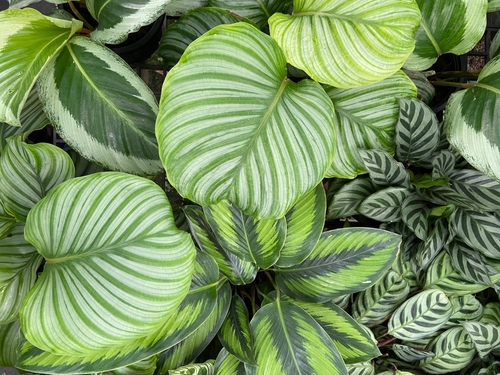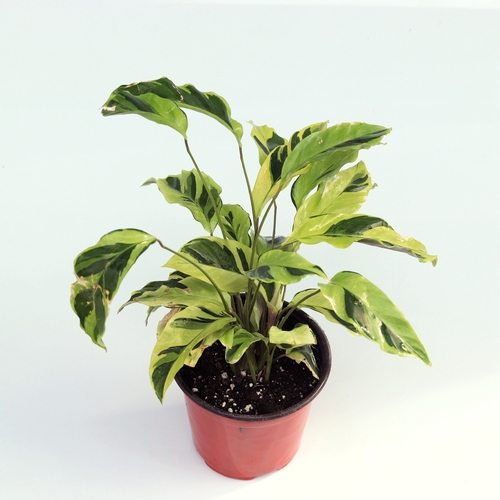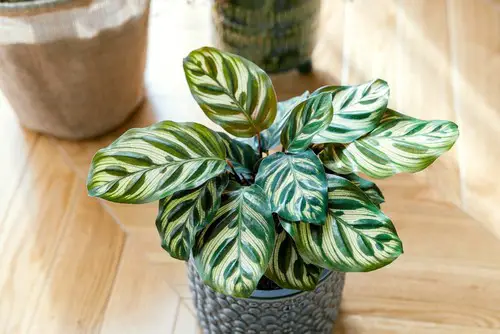Calathea plants are known for their beautiful, vibrant foliage, making them a popular choice for indoor gardening enthusiasts. However, if you notice your Calathea turning yellow, it can be a cause for concern.
Yellowing leaves are often a sign of stress or disease, and it’s important to understand the causes and treatments to keep your plant healthy.
Calathea plants require a specific set of conditions to thrive, including consistent moisture, warmth, and humidity. When these conditions are not met, the plant can become stressed and may exhibit symptoms such as yellowing leaves.
Understanding the causes of yellowing leaves, such as overwatering, underwatering, or inadequate lighting, is crucial in preventing and treating the issue.
If you’re experiencing yellowing leaves on your Calathea plant, don’t panic. With the right care and attention, you can nurse your plant back to health and restore its vibrant foliage.
In this article, we’ll explore the causes and treatments for yellowing leaves on Calathea plants, as well as some frequently asked questions to help you keep your plant healthy and thriving.
Key Takeaways
- Yellowing leaves on Calathea plants can be a sign of stress or disease.
- Causes of yellowing leaves include overwatering, underwatering, and inadequate lighting.
- Treating yellowing leaves involves identifying the cause and making adjustments to the plant’s care routine.
Also don’t miss:
- Why Is My Black Velvet Alocasia Turning Yellow?
- Why Is My Bird’s Nest Fern Turning Yellow?
- Why Is My Bird of Paradise Leaves Turning Yellow?
Understanding Calathea Plants

Calathea plants are tropical plants that are known for their beautiful foliage. They are easy to care for and are a popular choice for indoor plants. Calathea plants are part of the Marantaceae family, which includes other popular houseplants like prayer plants and arrowhead plants.
These plants are known for their large, colorful leaves that come in a variety of patterns and colors. They are often called “prayer plants” because their leaves fold up at night, as if in prayer.
Calathea plants are also known for their air-purifying properties, making them a great choice for those who want to improve the air quality in their homes.
Calathea plants are easy to care for, but they do have some specific needs. They prefer bright, indirect light and need to be kept in a warm, humid environment. They also need to be watered regularly, but not overwatered, as this can lead to root rot.
When it comes to calathea care, it is important to keep the soil consistently moist, but not waterlogged. It is also important to fertilize the plant regularly, using a balanced fertilizer that is specifically formulated for houseplants.
Symptoms of Yellowing Leaves
Yellowing leaves are a common symptom in Calathea plants that can indicate a variety of issues. Here are some symptoms to look out for:
- Yellowing leaves: This is the most obvious symptom of an issue with Calathea plants. The leaves may turn completely yellow or develop yellow spots.
- Chlorosis: Chlorosis is a condition where the leaves lose their green color and turn yellow. This is often caused by a lack of nutrients, such as iron or magnesium.
- Leaf drop: In severe cases, the leaves may drop off the plant entirely.
There are several reasons why Calathea leaves may turn yellow. Overwatering, underwatering, low humidity, and temperature extremes can all cause yellowing leaves. Pests and diseases can also be a factor.
If the yellowing leaves are accompanied by other symptoms, such as wilting or brown spots, it may indicate a more serious issue. It’s important to identify the underlying cause of yellowing leaves and address it promptly to prevent further damage to the plant.
In some cases, yellowing leaves may simply be a sign of old age. As Calathea plants age, their leaves may turn yellow and fall off. This is a natural process and not a cause for concern.
Why Is My Calathea Turning Yellow – 5 Common Problems

Calathea plants are known for their beautiful, vibrant foliage, so it can be concerning when the leaves start to turn yellow. There are several factors that can cause a Calathea plant’s leaves to turn yellow, including stress, temperature, humidity, light, watering, soil, and pests.
1. Stress and Shock
Stress and shock can cause Calathea leaves to turn yellow. Stress can be caused by a variety of factors, such as overwatering, underwatering, improper watering, or inconsistent watering. Shock can occur when the plant is moved to a new location or when there is a sudden change in temperature or light.
2. Temperature and Humidity
Calathea plants prefer warm temperatures and high humidity levels. Cold temperatures or temperature fluctuations can cause the leaves to turn yellow. Low humidity levels can also cause yellowing leaves. Direct sunlight or harsh direct sunlight can also cause the leaves to turn yellow.
3. Watering and Soil
Overwatering or underwatering can cause yellowing leaves. Calathea plants prefer consistently moist soil, but not soggy soil. Poor soil or soil with improper drainage can also cause yellowing leaves. Soil pH can also affect the health of the plant.
4. Fertilizer and Nutrient Deficiency
Over-fertilizing or under-fertilizing can cause yellowing leaves. Calathea plants require regular fertilization with a balanced liquid fertilizer. Nutrient deficiencies can also cause yellowing leaves.
5. Pests and Diseases
Pests, such as spider mites and mealybugs, can cause yellowing leaves. Fungal infections or bacteria can also cause yellowing leaves.
It is important to identify the cause of yellowing leaves in Calathea plants in order to provide the proper care. Addressing the underlying issue can help prevent further damage and promote healthy growth.
Preventing Yellowing Leaves
To prevent yellowing leaves on Calathea plants, it is important to understand the plant’s care requirements. Proper care can help ensure that the plant remains healthy and vibrant.
1. Watering Calathea Plants

Overwatering or underwatering Calathea plants can cause yellowing leaves. To prevent this, it is important to water the plant properly.
Water the Calathea when the top half-inch of soil feels dry, and water thoroughly so that it flushes out through the drain holes to carry away excess buildup. Only use rainwater or distilled water, as tap water can contain chemicals that can harm the plant.
2. Humidity and Misting
Calathea plants require high humidity to thrive. If the air is too dry, the plant’s leaves may turn yellow and dry out. To prevent this, mist the plant regularly or use a room humidifier. Grouping plants together can also help increase humidity levels.
3. Light and Temperature
Calathea plants prefer bright, indirect light, so placing them near an east-facing window is ideal. Avoid exposing the plant to direct sunlight as this can cause the leaves to curl, droop, and turn yellow.
Calathea plants also prefer warm temperatures between 60°F and 75°F. Avoid exposing the plant to temperatures below 60°F, as this can cause the leaves to fall off.
4. Pruning and Repotting
Pruning Calathea plants can help prevent yellowing leaves. Remove any yellowing or damaged leaves to encourage new growth. Repotting the plant every two years can also help ensure that it has enough nutrients to grow healthy leaves.
5. Pebble Tray
Placing a tray of pebbles under the Calathea plant can help increase humidity levels. Fill the tray with water, but make sure the water level is below the pebbles. This can help prevent the plant from sitting in standing water, which can cause root rot.
By following these care tips, Calathea plants can thrive and grow new leaves that are healthy and vibrant.
Treating Yellowing Leaves
When a Calathea’s leaves start turning yellow, it’s important to take action to prevent further damage to the plant. There are several steps that can be taken to fix yellow leaves on Calathea.
Firstly, overwatering is a common cause of yellowing leaves. To fix this issue, the plant should be watered less frequently. Only water the plant when the top half-inch of soil feels dry to the touch. It’s important to water the plant thoroughly, so that excess water can drain out of the pot.
Secondly, low humidity levels can also cause yellowing leaves. To increase humidity around the plant, consider using a humidifier or placing a tray of water near the plant. Misting the plant’s leaves can also help to increase humidity.
Thirdly, insect infestations can cause yellowing leaves. Insecticidal soap can be used to treat infestations of spider mites or mealybugs. Rubbing alcohol can also be used to remove these pests from the plant.
Lastly, nutrient deficiencies can cause yellowing leaves. Fertilizing the plant with a balanced fertilizer can help to prevent nutrient deficiencies.
Frequently Asked Questions

What causes yellowing of Calathea leaves?
Yellowing of Calathea leaves is often caused by overwatering, underwatering, poor lighting, low humidity, pests, or disease. Calathea plants are sensitive to changes in their environment, and any of these factors can cause stress that leads to yellowing leaves.
How can I prevent my Calathea from turning yellow?
To prevent your Calathea from turning yellow, make sure to provide it with consistent, slightly moist soil, but avoid overwatering. Keep the plant in a spot with bright, indirect light and high humidity.
Avoid exposing it to extreme temperatures or drafts. Regularly inspect the plant for signs of pests or disease and take action promptly if you notice any issues.
What is the best way to care for a Calathea with yellow leaves?
If your Calathea has yellow leaves, it’s important to identify the cause of the problem and take action accordingly. If the yellowing is due to overwatering, reduce watering frequency and allow the soil to dry out slightly between waterings.
If it’s due to underwatering, increase watering frequency and make sure the plant is getting enough moisture. If the yellowing is due to pests or disease, treat the plant with an appropriate remedy.
What are some common reasons for Calathea leaves to turn yellow?
Common reasons for Calathea leaves to turn yellow include overwatering, underwatering, poor lighting, low humidity, pests, or disease.
Additionally, Calathea plants are sensitive to changes in their environment, so any sudden changes in temperature, light, or moisture can cause stress that leads to yellowing leaves.
Can Calathea leaves recover from yellowing?
Calathea leaves can recover from yellowing, but it depends on the cause of the problem. If the yellowing is due to overwatering or underwatering, adjusting the watering schedule can help the plant recover.
If it’s due to pests or disease, treating the plant with an appropriate remedy can help. However, if the yellowing is due to extreme stress or damage, the leaves may not recover.
How do I treat yellowing Calathea leaves?
The treatment for yellowing Calathea leaves depends on the cause of the problem. If the yellowing is due to overwatering, reduce watering frequency and allow the soil to dry out slightly between waterings.
If it’s due to underwatering, increase watering frequency and make sure the plant is getting enough moisture. If the yellowing is due to pests or disease, treat the plant with an appropriate remedy.
If the yellowing is due to extreme stress or damage, it may be best to remove the affected leaves.

Hey, I’m Lisa and I’ve been an avid gardener for over 30 years. I love writing, talking and living in the garden! Feel free to connect with me on my socials below


